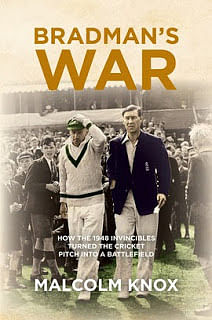
Book Review - Bradman's War by Malcolm Knox

This is my last book review of 2013 and is up there as one of the best I have read all year.
Malcolm Knox is a fine writer and this detailed look at the 1948 ‘Invincibles’ from Australia, who visited these shores under Donald Bradman, reads like the most exciting of novels. They were a fine side, though the austerity of post-war England and the ongoing issues with rationing meant that they were fitter and stronger than the sides they faced. Many of the county sides featured players from the pre-war era, most of them too old and too slow for the powerful physical specimens who confronted them. Younger players were very inexperienced and it was a one-sided contest.
The cricket authorities played into their hands as well, agreeing to a new ball every 65 overs that meant their key pace bowling spearheads, Ray Lindwall and Keith Miller, could lead the attack, come back for another burst then have the advantage of a hard new ball after tea. While the side had good spinners, they became a secondary consideration as Bradman aimed to batter the England side into submission. His experiences against Harold Larwood and Bill Voce in the winter of 1932-33 still rankled, as did the way that England had ground his side into the dust at The Oval in 1938, racking up 903 runs as Bradman was carried off with an ankle injury. The plans of his players, and those of England, to resume the Ashes in a new spirit of friendship were dashed very quickly
Bradman agreed to return to England for one last time in 1948, not content to play the hoped-for fun series in the euphoria of post-world war Britain, but intent on getting his own back on an England side that had a small number of good players but too many who were past their prime. He wanted to win not just the Test series, but to go through the tour unbeaten and leave an indelible memory on the cricketing public. He managed that, but at a cost.
It was a tour he nearly didn’t make after periods of ill-health, but while not the player of ten years earlier, his side had depth in batting and two of the greatest-ever fast bowlers. Bradman’s methods saw him come into conflict with members of his team, many of who had gone through the pressures of war and wanted only a pleasant sporting release against people they had fought alongside. There was a definite rift between those who had served and Bradman, who had been invalided from the war. Their discomfort at the tactics used is well-documented and the tale beautifully told.
It is a fine book and a memorable one. The depth of research is admirable, as the tour is documented in match by match detail. There’s only one error, unfortunately repeated twice in reference to a Derbyshire player of the time. We never had a player named ‘Fred’ Pope, who was apparently in the England reckoning in that summer. We did have Alf Pope and perhaps ‘Alfred’ is where the confusion has arisen, but he didn’t play county cricket after 1939. His brother George is the player referred to and I hope the error is corrected in a future paperback edition.
While it is probably too late to slip a Christmas hint to the someone special in your life, I’d heartily recommend this book to someone who likes a good read, enjoys cricket history and has a few quid in gift money to spend after the coming festivities.
It is definitely worth it.
Bradman’s War is written by Malcolm Knox and published by The Robson Press. It is currently available on Amazon for £13.20 and is available through all good book shops